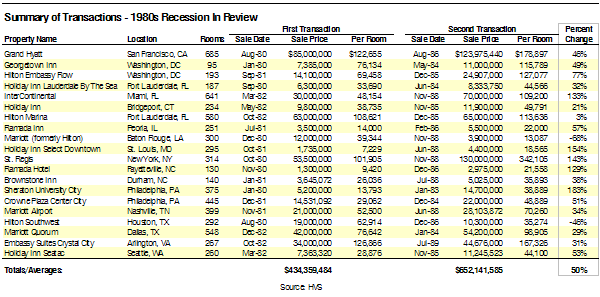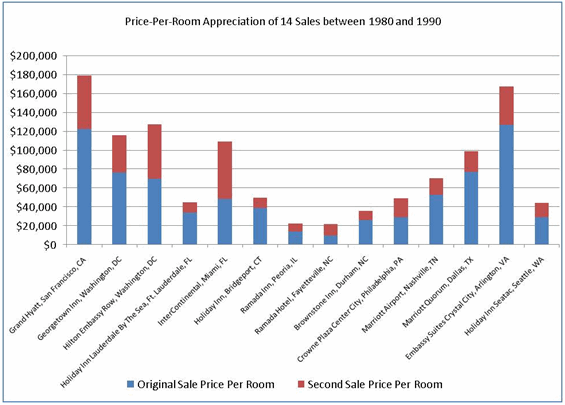
Transactions of full-service hotels are springing up again after a long drought. But is now the time to buy? What are the possible gains in hotel prices between now and the next peak?
Financing is scarce, and what’s available carries a high price tag or comes only with a conservative, in-place debt coverage ratio. Trailing twelve-month performance stats are at all time lows for many properties. These conditions have kept owners from rushing to sell their hotels. Even as a competitive market for high-quality assets once again drives discount rates below 12%, we’re still a far cry from the sub-10 rates the market dictated in the prior upturn. Moreover, cash flows are expected to remain relatively sluggish over the next 12 to 24 months due to depressed average rates, which are not likely to begin a recovery until later this year.
Though sales volume remains relatively low, 1Q 2010 saw 13 transactions above $10 million—up from 8 from recorded during the same period last year. These included a three-hotel, limited-service portfolio in New York City; the $112-million sale of the Hyatt Regency Boston; and the $63-million sale of the Marriott Los Angeles. The Marriott Los Angeles is of special note: the price at which it most recently sold fell roughly 55% from its sale price in March of 2007. Two hotels, the Sheraton Pleasanton and the Sea Crest resort, sold in 2010 on an individual, non-portfolio basis at higher prices than their sales in the 1990s. Nevertheless, recent hotel prices have overwhelmingly moved downward.
Given the recent uptick in sales, it’s prudent to look at how hotel prices fared in past recessions to form an outlook for opportune buyers. Many buyers purchased full-service hotels in past market troughs and sold four to eight years later—how did they fare? Did they see a windfall or just a fall? This article focuses on hotels that transacted during the 1980s recession and again years later. Future installments will review the cycles that followed.
Major Hotel Transactions and Prices in the Early 1980s Recession
The recession of the early 1980s impacted the U.S. hotel industry in multiple ways. Four straight years of demand declines, compounded by supply increases, caused occupancy to fall from a peak of nearly 72% in 1979 to just over 60% by 1984. High interest rates and a low availability of financing also contributed to a lack of new hotel builds during this time. Transactions activity declined as well. HVS recorded 293 hotel transactions between 1980 and 1982. In contrast, 1,583 transactions were recorded during the revival period from 1983 to 1990.
According to HVS research, 45 hotels that sold between 1980 and 1982 transacted again in the following eight years. Out of the 45 properties, 20 were full-service. Eighteen of these full-service hotels sold at levels 3% to 183% higher than their previous sales prices, an average appreciation of 50%.

make sure pop-ups are enabled on your browser
The properties with the greatest appreciation on a dollar basis were the Grand Hyatt San Francisco, the InterContinental Miami, and the St. Regis New York, with respective increases of $39 million, $40 million, and $76.5 million. The following chart reflects the price-per-room appreciation for the 14 transactions surrounding the median of the selected data.

make sure pop-ups are enabled on your browser
The two full-service properties whose prices did not appreciate in the 1980s did follow the national trend in the 1990s, realizing full price recovery and appreciation by 1996. The Marriott Baton Rouge, which dropped in price by nearly 70% from its 1980 sale price of $12 million, was branded as a Hilton in the 1980s. The price dropped again for its sale in 1988, but rose to $14.5 million when the hotel sold again in 1996. The Hilton Houston Southwest sold for $19 million in 1980, fell to a low of $7.6 million in 1989, recovered to $18.5 million in 1996, then fell again to $13.2 million in 2002—coincidentally, in the midst of the another recession.
Conclusion
The trends suggest that, for the majority of hotels, prices rose swiftly in the years immediately following the end of the early 1980s recession. Even the two properties with atypical price fluctuations during the 1980s followed the appreciation trend seen in the next decade, with sales in 1996 that showed net improvement from their previous peak-sale prices. A vast number of factors come into play when determining hotel values and outlooks on pricing, and not every property will conform to the trends of cycles past. But these data give perspective on the overall direction in which hotel prices are headed.
Stay tuned for insights on hotel price trends from later recessionary periods, and contact Rod Clough, MAI (214-629-1136, [email protected]) to learn more about hotel transactions and price trends in today's market.


I love reviewing the 80's-90's time period for cre and specifically hotels. Since living thru the and dealing with the sale of assets during this time, I believe this period of problems are being ignored or extended in hopes of better times. However, all the reports I read say we will be in this tough period for at least two more years. I believe it would be helpful to see how the markets priced the assets that sold during the downturn not when there was a recovery. My contention is that this time is different in several ways one is that if you had money during the 80's downturn, you could obtain financing to purchased the bad assets. Today you cannot obtain financing. Another difference is that the assets where repriced very quickly, relatively, and then put back in the marketplace in a short time period of months. Today we are waiting for something. What that something is, is anyone's quess. We have been through this before and I believe that the assets right now need to be repriced to market, get them to market and sale them. Fairly easy, except for the right offs that will incurred by the institutions. But by not repricing the assets, we are filling up a pipeline that is going to look like a BP leak.